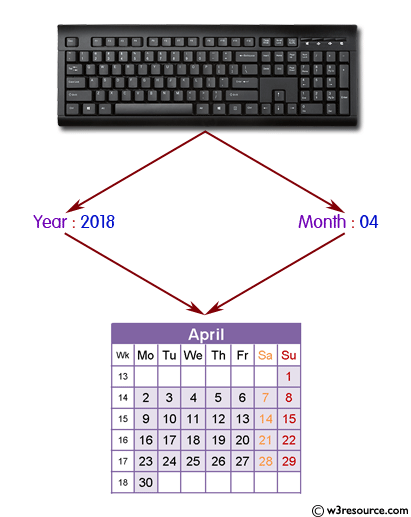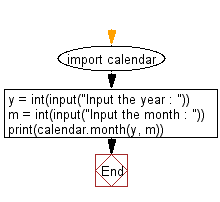Python: Calendar
Monthly Calendar Display
Write a Python program that prints the calendar for a given month and year.
Note: Use 'calendar' module.
Python calendar.month(theyear, themonth, w=0, l=0):
The function returns a month’s calendar in a multi-line string using the formatmonth() of the TextCalendar class.
'l' specifies the number of lines that each week will use.
Pictorial Presentation:

Sample Solution:
Python Code:
# Import the 'calendar' module
import calendar
# Prompt the user to input the year and month
y = int(input("Input the year : "))
m = int(input("Input the month : "))
# Print the calendar for the specified year and month
print(calendar.month(y, m))
Sample Output:
Input the year : 2017
Input the month : 04
April 2017
Mo Tu We Th Fr Sa Su
1 2
3 4 5 6 7 8 9
10 11 12 13 14 15 16
17 18 19 20 21 22 23
24 25 26 27 28 29 30
Explanation:
The said code imports the calendar module, which allows you to output calendars like the Unix cal program, and provides additional useful functions related to the calendar. It then asks the user to input an integer for the year and month.
The code then uses the month() function from the calendar module, which takes the year and month as arguments and returns a string containing an ASCII calendar for that month of that year.
Flowchart:

For more Practice: Solve these Related Problems:
- Write a Python program to display a calendar for an entire year.
- Write a script that takes a date and prints the weekday name.
- Write a Python program that prints the number of days in a given month.
- Write a script that highlights the current day when printing a monthly calendar.
Go to:
Previous: Write a Python program to print the documents (syntax, description etc.) of Python built-in function(s).
Next: Write a Python program to print the following 'here document'.
Python Code Editor:
What is the difficulty level of this exercise?
Test your Programming skills with w3resource's quiz.
